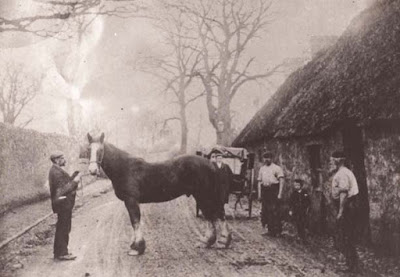
Horses
are absolutely necessary in this part of the country, for it is by them
the farmers labour their farms and drive their corn to market. They
never work with oxen now as they did formerly" - a quote from "The First Statistical Account of Scotland" written 1791-1799.
Sixty years on, the 1851 census for Earlston (including Mellerstain and Redpath) lists 9 men working as blacksmiths, 7 carters/carriers, 3 saddlers, 2 stable boys, an ostler, a farrier, a groom and a coachman - plus of course all those who would be working with horses on the many farms in the parish.
One of the most prominent families of blacksmiths in the village were the Brotherstons who worked in Redpath and Earlston down many generations and still man the Smiddy at the East End today.
Sixty years on, the 1851 census for Earlston (including Mellerstain and Redpath) lists 9 men working as blacksmiths, 7 carters/carriers, 3 saddlers, 2 stable boys, an ostler, a farrier, a groom and a coachman - plus of course all those who would be working with horses on the many farms in the parish.
The Old Smiddy on the Green
One of the most prominent families of blacksmiths in the village were the Brotherstons who worked in Redpath and Earlston down many generations and still man the Smiddy at the East End today.
In the 1851
census for Earlston Parish, 49 year old Andrew Brotherston, blacksmith was at Redpath with his wife Jessie and five children - Margaret, John, William, Isabella and young Andrew. Ten years on, he was still at Redpath where in the census, he was described as a "master blacksmith employing one apprentice". Andrew senior died in 1867.
John and Andrew followed their father in the family business and by 1881 were working in the East End, Earlston as "smiths and implement makers".
Slater's Royal National Commercial Directory of 1882 listed three blacksmith businesses in the village:
John Brotherston - also an agricultural implement maker
Robert Lee - also an agricultural impement maker and engineer
James Wilkie
John and Andrew followed their father in the family business and by 1881 were working in the East End, Earlston as "smiths and implement makers".
Slater's Royal National Commercial Directory of 1882 listed three blacksmith businesses in the village:
John Brotherston - also an agricultural implement maker
Robert Lee - also an agricultural impement maker and engineer
James Wilkie
By the time
of the 1901 census, John Brotherston was
at 119 High Street, with his wife Susan and young son James.
John was a prominent member of Earlston Horticultural Society, with his name featuring often in the local
press reports as a prize winner at the annual shows.
The 1903 Directory for the village showed John and his brother Andrew As blacksmiths. John died two years later in December 1905.
The 1903 Directory for the village showed John and his brother Andrew As blacksmiths. John died two years later in December 1905.
Continuing the family business in their ancestor's smiddy were John's son, James, and grandson John.
************
































 And finally the only photograph we
And finally the only photograph we 